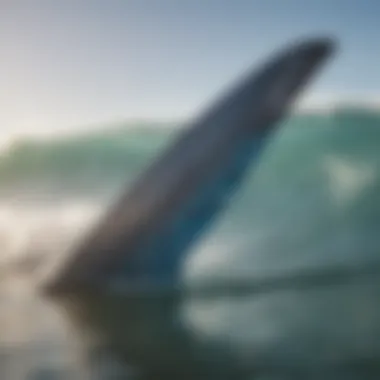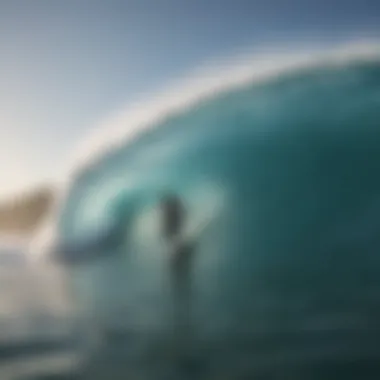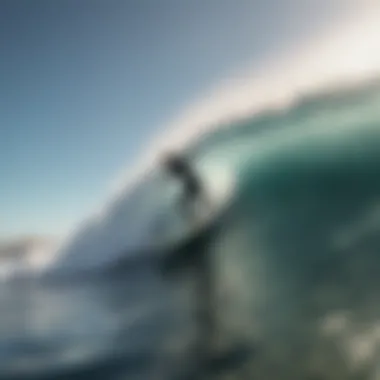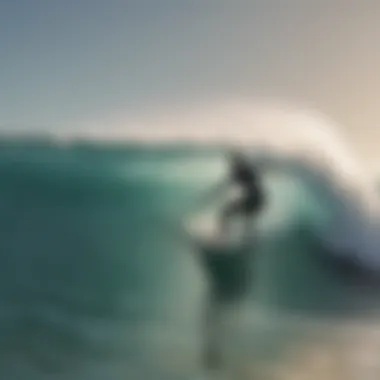Exploring the Performance of Mark Richards Fins


Intro
The world of surfing is not just about riding waves; it's about mastering the art of balance, timing, and equipment. Among the numerous pieces that come together when surfers gear up, fins play a crucial yet often overlooked role. Mark Richards, a name synonymous with surfing innovation, has revolutionized fin design, impacting how both budding surfers and seasoned veterans approach the sport. Delving into the intricacies of Mark Richards fins is essential for anyone serious about enhancing their surf experience. This journey of discovery focuses on the multifaceted nature of these components, guided by years of refinement and an understanding of surf dynamics.
Exploring the design elements of Mark Richards fins reveals a commitment to enhancing performance. Whether you are looking to upgrade your surfboard setup or simply want to understand how fins change your ride, this article aims to bridge the gap between technical jargon and practical understanding. In addition, we will look at how these fins fit into various surf conditions, from mellow beach breaks to aggressive reef breaks, giving you insight that can directly influence your time on the water.
Let's dive into the essential techniques that surfboarders can employ, whether they are looking to perform advanced maneuvers or just hoping to catch that first wave. Understanding these techniques is paramount, especially when equipping yourself with the right gear.
Surfing Techniques
Advanced Maneuvers for Experienced Surfers
When riding waves as a pro, your fin choice can elevate your game. Mark Richards fins are designed with an acute attention to detail, allowing experienced surfers to execute complex maneuvers with precision. Some key techniques include:
- Vertical attacks: Utilizing the fins to drive upward off the wave face enables speed and radical positioning.
- Carves and cutbacks: A fin’s flexibility and shape significantly influence how sharply and effectively these movements can be performed.
- Aerials: Fins play a crucial role in achieving aerial tricks, allowing for better lift and control during jumps.
As you push the limits, remember that every surfer's style is unique, and fin configurations exist to complement those differences. Experimenting with versatility, such as adjusting the fin setup or trying twin or thruster configurations, can refine your performance.
Beginner Tips for Catching Your First Wave
For those just starting, the journey might feel daunting, but having the right mindset and gear can make a world of difference. Here are some practical tips:
- Choose the right board: Start with a longer, wider board for stability. Look for boards with softer edges—it helps with balance.
- Understand wave dynamics: Look for gentle, rolling waves as they’re easier to catch compared to steep ones.
- Positioning matters: Paddle out to the spot where the waves break. Turn your board towards the shore just as a wave approaches.
- Paddle with strength: A powerful paddle helps you catch the wave at the right moment. This is where effective fin design comes into play, especially when you’re trying to gain speed.
Remember, catching waves is about timing and understanding your equipment. The right fins can help keep your craft stable while you find your groove.
"Understanding your gear is just as important as mastering the waves. Mark Richards fins are about compatibility with your surfing style."
In the following sections, we will explore gear reviews, focusing on how the latest surfboards and additional accessories can complement your surfing journey, ensuring both safety and performance on the water.
Preamble to Mark Richards Fins
When one thinks of surfboarding, the intricate balance of the board’s dynamics becomes apparent, especially when it comes to fins. These small yet crucial components significantly influence the overall experience while riding the waves. Mark Richards fins represent a hallmark of design and functionality, deeply anchored in both performance and legacy. Understanding their role not only helps surfers make informed choices but also enriches their relationship with the sport.
The Legacy of Mark Richards
Mark Richards, often hailed as a surfing prodigy, made waves both figuratively and literally in the surfing world. In his heyday during the late 1970s and early 1980s, he wasn’t just another surfer; he was a revolutionary force. His innovative designs in fin technology opened up new avenues for performance, enabling surfers to execute maneuvers that were unheard of at the time.
Richards' approach to fin design was influenced not only by his competitive edge but also by a desire for better interaction between the board and the water. His twin-fin setup was a game changer, allowing for an unexpected reaction in the waves, resulting in increased speed and fluidity. This unique contribution paved the way for modern surfboard fin designs, emphasizing why understanding Mark Richards fins is essential for any serious surfer.
Understanding Fins in Surfboarding
Fins, though often overlooked, play a pivotal role in determining how a surfboard reacts to different wave conditions. They are the unsung heroes, quietly influencing everything from maneuverability to stability. Surfboard fins function similarly to the rudder on a ship: they help steer and guide the board through the waters, allowing the surfer to maintain control while riding unpredictable waves.
Here are a few key aspects of fins in surfboarding:
- Direction Control: Fins help steer the surfer where they want to go, making changes in direction easier and more precise.
- Speed Generation: The right fins can enhance speed by reducing drag in the water, allowing surfers to coast smoothly.
- Stability: A well-placed fin can stabilize the board, especially in choppy conditions, making for a more enjoyable ride.
In essence, understanding how fins influence these factors may not only elevate a surfer’s performance, but also deepen their engagement with the surf culture itself. As we delve further into the specifics of Mark Richards fins, it becomes clear that their design and historical significance continue to shape the surfing landscape today.
"Fins may appear simple, but their impact fundamentally alters the way surfers interact with the ocean."
This exploration into Mark Richards fins is not just a technical analysis; it’s a celebration of how innovative design and performance intertwine, igniting passions and fueling dreams for surfers around the globe.
Design Elements of Mark Richards Fins
The charm of surfboarding often lies in the equipment's subtleties, particularly when it comes to fins. Mark Richards has made quite a significant footprint in the realm of surfboard fins, marrying design elegance with performance effectiveness. Diving into the design elements of Mark Richards fins, we can truly appreciate how these features contribute to an unparalleled surfing experience. It's not just about gliding across the water; it’s about how every aspect of a fin can alter the feel of a ride, influencing maneuverability, stability, and overall performance.
Fin Shape and Size
Fin shape and size stand as the backbone of surfboard dynamics. For surfers, choosing the right fin can make the difference between a smooth ride and a frustrating struggle against the waves. Mark Richards fins exhibit a unique design that remains functional yet aesthetically striking.
The size of a fin often correlates with its intended surfing conditions:
- Larger fins are generally suited for big waves, providing extra hold and stability. These are perfect for those who revel in the challenge of powerful surf.
- Smaller fins, on the other hand, allow for quick maneuvers, making them ideal for playful surf or tight conditions.
- Medium-sized fins strike a balance, offering versatility for a wide range of surfing styles.
The shape also plays a critical role in how a surfer interacts with the water. The more vertical the fin’s profile, the sharper the turns achievable; conversely, a more rake (angled back) allows for smoother transitions and power in bigger faces. For instance, a fin with a wider base can aid in generating drive, while a narrower tip can facilitate versatility in trick skiing.


Richards understood the nuances involved; his fins are crafted with diverse shapes and sizes, targeting various riding styles and wave conditions. Ultimately, the right fin is about what feels good and empowers the surfer, marrying personal preference with performance needs.
The Role of Flexibility
Flexibility is often an underappreciated aspect in the design of surfboard fins yet can have a huge impact on how a surfboard behaves on the water. When we talk about flex, it’s not merely about how much a fin can bend; it is about the responsiveness it offers during a ride, determining how effectively a surfer can engage with the waves.
- Stiffer fins translate to more power and stability, making them ideal for larger waves where control is paramount.
- Flexible fins, however, can bend during turns, storing energy and allowing for higher speed in subsequent maneuvers. This can lead to a more fluid ride, which many riders may enjoy in smaller, playful waves.
Mark Richards designed his fins to harness this duality. He incorporated different levels of flexibility into various models, giving surfers the option to choose based on their style and current conditions. It’s not just about choosing a fin; it’s about what that fin can do for you in terms of connection to the water. In essence, the flexibility of Richards' fins allows surfers to tailor their response, creating a dynamic interaction with the waves.
Flexibility in fins is like the rhythm of a good song; without it, the ride just doesn't flow.
Finding the right balance between shape, size, and flexibility can dramatically transform a surfer’s experience. Mark Richards' approach to fin design not only highlights these elements but also elevates the overall surfing art, blending function with flair in a way that resonates with both novice and seasoned surfers alike.
Performance Benefits
When one talks about surfboarding, it often brings to mind the thrill of gliding over waves. However, what truly elevates this experience lies in the nuances of the equipment used, particularly the fins. Mark Richards fins stand out for their performance benefits, which can significantly affect a surfer's overall experience in the water. These advantages are not just conveniences; they can alter the very dynamics of how a board behaves in different conditions.
Fins play a critical role in a surfboard's performance. They can determine how well a rider can maneuver, how stable the ride feels, and how effectively the board can handle various wave conditions. Here, it's crucial to dissect these attributes further.
Enhanced Maneuverability
Maneuverability, in the realm of surfing, can mean the difference between a smooth turn and a wipeout. When we discuss Mark Richards fins, one cannot overlook their contribution to enhanced maneuverability. The specific design elements of these fins, including their shape and size, encourage not only swift turns but also precise action in challenging conditions.
Key Considerations:
- Shape: The distinctive, often slightly tapered design of Mark Richards fins aids in reducing drag while enabling quicker direction changes. This geometry allows for effortless turns, helping novice and experienced surfers alike employ advanced techniques more efficiently.
- Size: The fin's size is essential; larger fins often offer more grip but can hinder quick turns. Balance is key. Mark Richards has optimized this ratio to ensure that surfers can enjoy the best of both worlds.
- Flexibility: The ability of the fin material to flex adds another layer of responsiveness. This ensures that when pressure is applied during maneuvers, the fin can flex slightly rather than becoming rigid, allowing for smoother transitions between movements.
In essence, having a fin that provides enhanced maneuverability translates into a more dynamic surfing experience. Surfers can execute tricks with more confidence, leading to an overall greater enjoyment of the sport.
Stability in Differing Conditions
Stability is equally as critical as maneuverability for surfers. It’s remarkably vital when grappling with varying wave dynamics. Surfers, especially those navigating more tumultuous or unpredictable waters, rely on fins that maintain their performance regardless of situational challenges.
Factors Influencing Stability:
- Material Composition: Fins made from advanced materials like fiberglass or composites provide a level of durability and rigidity. This ensures consistent performance whether you're riding glassy waters or tackling more choppy surf.
- Fin Placement: The positioning of these fins on a board impacts stability significantly. Mark Richards fins are often designed with strategic placement that enhances balance, minimizing the chances of nosediving or losing traction in size-changing swells.
- Toe and Cant Angles: These technical attributes mean how the fin is angled relative to the board and can fundamentally affect stability. Properly configured angles can maximize grip and control during aggressive surfing.
As such, the robustness of Mark Richards fins helps surfers maintain control, making every ride feel more predictable and secure, regardless of the conditions.
"A surfer's connection with the ocean is mirrored in the equipment choices they make. With the right fins, one can dance on waves rather than just ride them."
Through understanding these performance benefits, it's clear that Mark Richards fins are not merely an accessory but rather a key component that defines the quality of a surfboarding experience. Adequate attention to the features of these fins will empower surfers to elevate their skills while adapting easily to the ever-changing nature of the waves they take on.
Materials Used in Mark Richards Fins
The materials used in Mark Richards fins play a crucial role in not only the performance but also the longevity of the fins themselves. As surfers seek to enhance their experience on the waves, the choice of materials has evolved over the years. In this section, we will delve into two primary materials: fiberglass and composite materials, highlighting their benefits and particularities.
Fiberglass vs. Composite Materials
Fiberglass fins have long been a staple in the surfing world. They are known for their rigidity and responsiveness. When a surfer engages in sharp turns or quick maneuvers, these fins typically provide direct feedback to the board, allowing for sharp responses which many high-level surfers appreciate. Fiberglass is also fairly cost-effective, making it widely accessible. However, they come with their limitations; their rigidity might not suit every surfer’s style, particularly those looking for a more forgiving, flexible fin.
On the other hand, composite materials have gained traction in recent years. Composites are lighter and can be engineered to provide varying levels of flexibility. They are often designed to utilize a blend of materials that can absorb shock—ideal for choppy waters or when tackling larger waves. This ability to customize has made them a favorite among competitive surfers who need to adapt to different conditions. Furthermore, many composite fins are designed with enhanced durability in mind, thus reducing the frequency of replacements.
"Choosing between fiberglass and composite can feel a bit like trying to pick a favorite child—each has unique strengths that suit different surfing styles."
Key Comparisons:
- Weight: Composites are generally lighter than fiberglass.
- Flexibility: Fiberglass fins are more rigid, whereas composites can be tailored for various flex patterns.
- Durability: Composites are often more resistant to dings and wear, making them last longer in harsh conditions.
Environmental Considerations
When considering materials for fins, it is essential to weigh the environmental impact they pose. As surfers, many of us feel a deep connection to the oceans and are increasingly aware of our ecological footprint.
Fiberglass production, while offering excellent performance, often involves harmful chemicals and processes that can contribute to environmental degradation. The resin typically used in fiberglass fins can release volatile organic compounds (VOCs) that are not only harmful to human health but also detrimental to marine ecosystems.
Conversely, composite materials have begun to incorporate more sustainable practices and eco-friendly materials. Brands are starting to adopt recycled components and more responsible manufacturing methods, enabling surfers to enjoy great performance while also being more mindful of their impact on the environment.
Moreover, choosing eco-friendly fins doesn’t mean compromising quality. Many surfers report that the latest composite technology provides results that rival traditional materials without the guilt.


In summary, the choice of materials in Mark Richards fins transcends performance; it invites consideration of sustainability as well—an evolving narrative that aligns with the ethics of today’s surf community. Understanding these materials empowers surfers to make choices that favor not just their performance but the health of the oceans they cherish.
Historical Significance
Understanding the historical significance of Mark Richards fins provides a lens through which to view not just the development of surfboard technology but also the evolution of surfing culture itself. As surfing matured from a niche ocean sport to a global phenomenon, the innovations that accompanied this growth reflected broader shifts in technology, style, and consumer preferences. Mark Richards played a pivotal role in this transition, making his contribution critical for both present-day surfers and historians alike.
The Evolution of Surfboard Fins
The journey of surfboard fins is a tale as old as surfing. Early surfboards were rudimentary, often shaped from wood and lacking any appendages. The introduction of fins marked a monumental leap in control and performance on the waves. Initially, fins were simple and primarily functional. However, as the sport evolved, so did fin design.
By the late 1970s, the single fin setup was commonly used. This design was easy to ride and offered stability, which was paramount for rounding those tight corners. Yet, it constrained maneuverability, leading to the emergence of the twin fin and tri-fin systems.
Mark Richards took this progression one step further. His innovations, particularly the symmetrical, deeper fins, allowed surfers to carve more aggressively. This opened the doors for new styles of surfing, showcasing his influence not just on fin technology, but on surfing technique itself. Essentially, Richards' designs were like giving a sports car an engine tune-up, allowing surfers to harness the energy of the ocean more effectively.
"Fins may seem like a small detail, but they are the unsung heroes of surfboard design, shaping not only how we ride but the very culture of the sport itself."
Mark Richards' Contribution to Surfing
Mark Richards is not just a name, but rather a beacon of innovation in surfing. His work transcended ordinary boundaries, propelling surfboard design into an era of superior performance. Richards introduced the concept of four fins—dubbed the “quads”—to the surfing world. This radical setup provided surfers with a blend of speed and control that was previously unheard of.
Moreover, behind every design decision was Richards' philosophy that emphasized not just speed, but also adaptability. Surfboards needed to navigate various surf conditions, and his fins helped degree of flexibility and precision that enhanced the rider's experience, adapting them to every wave.
The impact of Richards’ designs cannot be overstated. Surfers began to explore more rail-to-rail transitions, carving with newfound liberation and confidence. Mark Richards didn’t just create fins; he shaped a new wave of surfing mentality that embraced innovation. In many ways, his contributions solidified a community that continually strives for excellence, embracing technology while paying homage to surfing’s rich heritage.
Application in Various Surf Conditions
Understanding how fins perform in different surf conditions is crucial for any surfer aiming to enhance their experience on the waves. Mark Richards fins represent a blend of tradition and innovation that accommodates a vast array of surfing styles and water environments. A surfboard’s fin setup is not just an accessory; it directly affects maneuverability, speed, and overall ride dynamics. Streetwise surfers often say, "Choose your weapon wisely," highlighting the significant role fins play. Therefore, exploring the compatible conditions for these fins and choosing the right ones for various waves helps surfers maximize their potential.
Compatible Conditions for Fins
When it comes to fins, knowing where and how to use them is essential. Mark Richards fins perform best in varying wave types, from mellow beach breaks to powerful reef breaks. Here are some conditions to consider:
- Small, Choppy Waves: Mark Richards fins, with their unique shapes, stabilize boards in choppy waters. They help maintain control, making rides smoother even when Mother Nature throws a curveball.
- Steep, Hollow Waves: In these scenarios, performance is everything. The flexibility and sharp edge of Richards’ fins allow for quick turns and tight arcs, essential for cutting through steep wave faces.
- Cruisy Point Breaks: These fins are designed for optimal glide and speed. Surfers can ride the wave longer and build momentum, leveraging the fin's design to generate speed on less dynamic faces.
Furthermore, the adaptability of fin design emphasizes the diversity in surfing styles. Certain configurations may enhance performance in soft and fat waves, while others will excel in steep and hollow situations.
"Using the right fin for the condition is like putting on the right shoes for a race; it makes all the difference in performance."
Choosing Fins for Different Waves
Selecting the appropriate fins for different wave types is like finding the right tool for a job. Mark Richards fins come in a variety of shapes and sizes, each suited for specific conditions. When weighing the options, consider the following:
- Type of Wave:
- Board Design:
- Personal Style:
- For fast, powerful waves, choose stiffer fins that allow for sharp turns and offer stability at high speeds.
- Soft, mushy waves may require more flexible fins to aid in maneuverability, allowing surfers to navigate with ease.
- Shortboards benefit from smaller fins for agility, while longboards often perform better with larger fins that provide more drive.
- A surfer's style significantly affects fin choice. Some prefer explosive turns, while others value smooth rides.
By understanding how different fins can enhance performance across various wave conditions, surfers are better positioned to make informed decisions that complement both their abilities and the nature of the surf. The right fin selection not only enhances the joy of riding but also fosters a deeper connection between the surfer and the wave.
The Community Around Mark Richards Fins
The community surrounding Mark Richards fins holds significant value in understanding their impact on surfboarding. These fins are not merely components of a surfboard; they represent a broader culture that connects surfers, manufacturers, and enthusiasts alike. Community interaction can lead to valuable insights that improve fin design and performance, creating a feedback loop that benefits everyone involved. The collaboration between users and developers ultimately enhances the surfing experience.
User Testimonials
Feedback from users of Mark Richards fins is remarkably varied, each story highlighting personal experiences that contribute to the collective knowledge. Many surfers fundamentally recommend the fins for their unique blend of agility and stability. One prominent user notes how switching to the MR-2 model dramatically changed their performance in choppy waters, allowing for smoother turns and sharper cuts. This varied response to user experience emphasizes how tailored choices in fins can impact individual surfers significantly.
Responses can also be found on platforms such as Reddit, where discussions frequently spotlight various fin setups. Whether a surfer describes the feeling of gliding on waves with a set of twin fins or the control achieved with a thruster configuration, these tales often provide beginners with guidance and seasoned surfers with fresh perspectives. In addition,
every surfer’s journey with their fins is unique, making these accounts invaluable for the community at large.
Influencer Perspectives
Influencers in the surfing world often echo the sentiments of the broader user community. Their reach can amplify discussions about the impact of specific fin designs on performance. Social media platforms act as a battleground for sharing knowledge, with influencers regularly posting reviews and tutorials that cover the extensive range of Mark Richards fins. They showcase not only the technical aspects but also the emotional connection surfers feel when navigating waves.


Taking a closer look at how influencers utilize these fins in their daily routines reveals the benefits of experimentation with setups. They often demonstrate the adaptability of Mark Richards’ designs across various conditions, from mellow beach breaks to more aggressive point breaks. This practical feedback loop allows followers to grasp the nuances of fin selection and application, encouraging them to think critically about what suits their own styles.
"Choosing the right fin can be the difference between hitting the wave perfectly and wiping out. It’s like picking the right shoes for a marathon. Each setup tells your surfing story."
- Surfer influencer
By engaging with both user testimonials and influencer perspectives, a richer understanding of the dynamics that drive the popularity of Mark Richards fins emerges. This community is not just a set of users; it is a thriving ecosystem where shared experiences foster improvement and innovation in surfboard design and performance.
Selecting the Right Fin Setup
Choosing the proper fin setup is crucial for any surfer hoping to improve their performance in the water. The fins may appear small in size compared to the rest of the board, but their role cannot be understated. They affect speed, maneuverability, and stability. Getting it right can mean the difference between a thrilling ride and a frustrating wipeout. This section unpacks why surfers need to pay attention to their fin setups and some key considerations in the process.
Understanding Fin Systems
Surfers often encounter different fin systems, which primarily determine how the fins interact with the surfboard. Some of the most popular systems are the FCS (Fin Control System) and Futures. Each system has its compatibility and benefits.
- FCS: This particular system uses two tabs to secure the fins into place. Easy to use and widely adopted within the surfing community, FCS fins come in various sizes and shapes, allowing surfers to customize their ride.
- Futures: Unlike the FCS system, the Futures rely on a single tab and screw mechanism. These fins are known for their durability and performance. They tend to have a stronger hold, ideal for aggressive surfers.
When selecting a fin system, understand how it fits with the surfboard in use. A fin meant for a specific system may not secure properly in a different one, which can lead to poor performance and ultimately will damage the board or lead to an accident in the waves. This could be particularly dangerous during a session when the stakes are high.
"Choosing the right fin system is just as important as picking the right board. Each has its own nuances that can dramatically change your ride."
Experimenting with Different Configurations
Not all surfers ride the same, thus not all fin configurations will work for everyone. Trying out various setups can help you dial in the perfect configuration for your style and the conditions you normally surf in. Here’s a closer look at some configurations you might consider:
- Single Fin: Great for longboards, this configuration offers a classic feel and smooth ride, perfect for cruisers on small waves.
- Thruster: This setup includes three fins and is widely popular among shortboarders. It provides a balanced mix of stability and maneuverability, making it suitable for a wide range of conditions.
- Quad Fin: Featuring four fins, this setup enhances speed and can be particularly effective in larger waves, helping the board to catch and maintain speed.
- Twin Fin: Ideal for those who value looseness and speed, twin fins allow for quick turns, great for those playful days in the surf.
Key Considerations:
- Wave Conditions: Some configurations do better in certain types of waves. For instance, a thruster might suit more varied conditions, while a quad is better for bigger water.
- Personal Preference: Ultimately, what feels best when you’re riding is a significant factor. Don’t be afraid to test out various setups until you find one that feels just right.
- Performance Goals: Think about what you want to achieve during your surf. Are you looking to carve tight turns or generate maximum speed? The fin configuration can help you meet those goals.
Maintenance and Care for Fins
Caring for surfboard fins is often undervalued in the surfing community. Many riders focus on board shape and wax, overlooking the pivotal role fins play in performance. Maintaining your fins not only prolongs their life but also enhances your overall surfing experience. This focus on maintenance can mean the difference between a smooth ride and a snagging disaster out in the waves.
Cleaning Techniques
One of the first steps in fin maintenance is proper cleaning. Surf fins, particularly once they’ve been in the water, can accumulate salt, sand, and grime faster than you can say "wipeout." These deposits can lead to corrosion and impacts performance. Here are some steps to effectively clean your fins:
- Rinse with Fresh Water
Immediately after surfing, rinse your fins with fresh water. It helps wash off that abrasive salt and sand. This simple act can extend their longevity dramatically. - Gentle Scrubbing
For stubborn dirt, use a soft brush or cloth. Avoid harsh scrubbing, as it may scratch the fin surface. Think of it like washing a delicate piece of art—gentle but thorough. - Use a Mild Cleaner
If grime still clings to the fins, try a mild, biodegradable cleaner. Make sure to rinse properly afterward to avoid any residue. Remember, your fins aren’t just there for decoration; they work hard! - Drying
Allow your fins to air dry fully before storing them. Storing wet fins can lead to mold or mildew, compromising their integrity. It's like letting a wet towel sit in a corner—gross and unnecessary.
Implementing these cleaning techniques will ensure your fins maintain their performance edge and last longer.
Storage and Handling Tips
When it comes to storage and handling, taking a few precautions goes a long way. Here are some effective practices to keep your fins in tip-top shape:
- Cool and Dry Environment
Store your fins in a cool, dry place. Excess moisture or heat can warp or deteriorate materials, so think twice before throwing them in a damp garage. - Use a Fin Bag
A fin bag is an easy way to protect your fins from scuffs and scrapes. It’s like wrapping them in a cozy blanket when not in use. Make sure the bag is well-padded too. - Avoid Direct Sunlight
Exposure to direct sunlight can lead to discoloration and weaken the material. Store them away from windows or in UV protective bags. - Separate Storage
If possible, store fins separately from the board, particularly if they’re removable. This practice minimizes the risk of accidental bending or breaking during transport.
Keeping surfboard fins in prime condition means they won't let you down when you want to shred those perfect waves.
By following these simple maintenance and care guidelines, surfers can enjoy not just better performance but also a more reliable surfing experience. It turns out those little details—the way you clean and store—can make a big ripple in your overall enjoyment out on the water.
Finale and Future Trends
As the waves keep crashing and the sport of surfing continually evolves, the importance of Mark Richards fins emerges sharper than ever. Focused not just on designs that echo the past, but on innovations that meet future challenges, these fins serve as a lens through which we can examine not only personal performance but the trajectory of surfboard engineering itself.
Emerging Technologies in Surfboard Fins
The surfing community stands on the brink of a technological renaissance for fins. Over the years, technology has seeped into various facets of surfboard construction, and fins are no exception. The advent of computer-aided design (CAD) has allowed for precision that simply wasn’t feasible before. This results in fins that are custom shaped to optimize water flow, ensuring every last drop is harnessed for speed and agility.
Moreover, 3D printing is making waves—no pun intended—in the fin industry. Not only does it offer the chance to create complex geometries, but it also allows for quick prototypes. Shapers can now rapidly test and modify designs. This iterative process is pretty crucial; surfers are always on the lookout for that small tweak that could mean the difference between a great ride and a miraculous performance.
Some companies are also exploring the use of smart materials that can alter properties based on conditions. Imagine fins that adapt their stiffness depending on wave size—offering more flex in smaller surf and a stiffer response in larger conditions.
"The future of surf fins is not just about performance, but about blending technology with a surf culture that appreciates craftsmanship."
Mark Richards' Continuing Influence
Mark Richards' footprints in the surf world aren't likely to fade away anytime soon. His unique approach to fin design doesn’t just influence current products, but it also shapes how new generations of surfers and shapers think about performance. The dialog around fins has shifted, with a greater emphasis on personal feel and feedback—which shows the lasting impression of Richards' philosophy focused on connection with the wave.
Upcoming surfboard shapers often cite his work as an essential part of their learning curve. With the discussion of fin configurations becoming a central topic at surfboard shaping expos and forums, Mark's designs form a backdrop against which many innovations are measured. His legacy activates passionate debates about what makes a fin work best—bringing not just performance, but depth to the conversation.
In a world where everything seems rushed, the importance of skilled craftsmanship is overshadowed by marketing hype. However, Richards reminds the surfing community that time-honored methods can lead to remarkable results. Surfers today can still tap into the ethos of Richards: intuitive, responsive, and aesthetically pleasing designs that invite heartfelt connection between the surfer and the sea.















